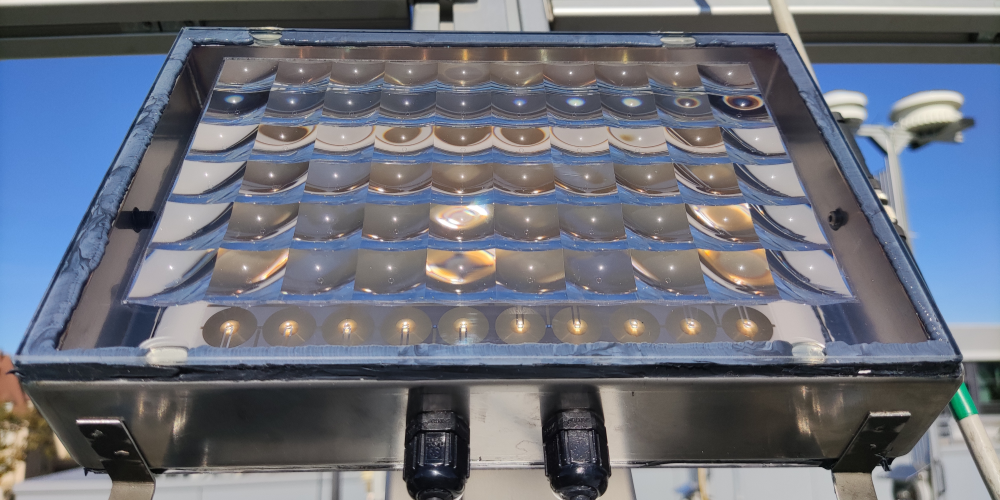Researchers in Germany have unveiled new highly efficient photovoltaic technology for micracular concentrator that enters into built-in production processes for micro-components to enable lower costs. A demonstrator who was dependent on the Micro-CPV module achieved the efficiency of 36% based on IEC62670-3 Concentrator standard test conditions.
The Fraunhofer Institute for Solar Energy Systems (Fraunhofer ISE) of Germany has developed new high efficient, cheap, micrivoltaic technology (micro-CPV) technology for applications in Agrivoltaics applications and power plants in sunny dry climate zones.
In view of an evolution of conventional concentrator photovoltaic (CPV), the Micro-CPV module is based on Geminiaturized solar cells with multiple junction and miniaturized optical components to reduce size, while efficiency keeps high. The smaller size offers potential cost and performance benefits, as well as production benefits, such as being able to integrate an established printed circuit board (PCB) and micro-electronics device manufacturing processes.
The Micro-CPV technology of the Fraunhofer is the result of four years of research with industrial and academic research partners. It is based on a cheap lens series, spherical secondary optical lens and small high efficient III-V concentrator solar cells (<1 mm2). The Five-Junction III-V micro-solo cells were supplied by Azur Space Solar Power.
In comparison with the state-of-the-art, this micro-CPV design reduces the amount of semiconductor materials required by 1,300 times and module areas by 30 percent and it reduces it, according to Fraunhofer Isee.
It is intended for implementation on 2-axis tilt and role trackers.
“We are currently preparing a startup, Clearsun Energy for commercializing the Micro-CPV technology, both for Agri-PV and PV energy plants in dry regions of the word,” Frank Dimroth, head of photovoltaic and concentration technology at Fraunhofer Isee, told, told PV Magazine, Add that a product with 37% module efficiency is planned.
In the study, “Power rating of a new micro-CPV module concept and operational influences“Recently published in Ieee ExploreThe performance of the Micro-CPV demonstration module of the Fraunhofer Isee are equipped with 60 cells units and an opening area of 205.35 cm2 was investigated. The researchers collaborated with a team from the University of Freiburg
The measurement data was collected in a year from a test tracker setup with double axis at the CPV test site of Fraunhofer Isee in Freiburg, Germany ending in February 2024. The monitored performance registered a monthly median efficiency between 31.4% and 33.6% among the prevailing circumstances.
For the power classification according to IEC62670-3, the demonstration module had an efficiency of 36.0% at Concentrator Standard Test conditions (CSTC) and 33.0% at Concentrator Standard Operating Conditions (CSOC) with operational cell temperatures around 75 C.
The researchers noticed on the “overall stable performance” of the module and “no signs of breakdown”, with which they concluded that the “very high efficiency” of the micro-CPV demonstration module was particularly proof, given that the unit was based on commercially available cheap components and high-throughput-presses.
In addition to the Power Rating Study, a new statistical model was developed for tolerance assessments of cells components because small deviations in the size and arrangement, which usually occur in real modules, have an effect on overall performance.
In the “Effect of Production tolerances on Micro-CPV assemblies: a quantitative approach based on statistical modeling, ” Published in Solar -energy materials and solar cells, The researchers describe the model and how the model was developed and applied to Micro-CPV, and concluded that it was a “crucial tool for identifying and assessing critical tolerances within a production line.”
In the meantime, the Micro-CPV technology has been scaled to modules of 60 cm x 45 cm. Field tests in Spain are underway with research partner Solar Tracker manufacturer Soltec to test one of the 60 cm x 45 cm modules with a new tracking system equipped with non-functional dummy modules and sensors to support monitoring.
Image: Image: Fraunhofer Isee
This content is protected by copyright and may not be reused. If you want to work with us and reuse part of our content, please contact: editors@pv-magazine.com.
Popular content


